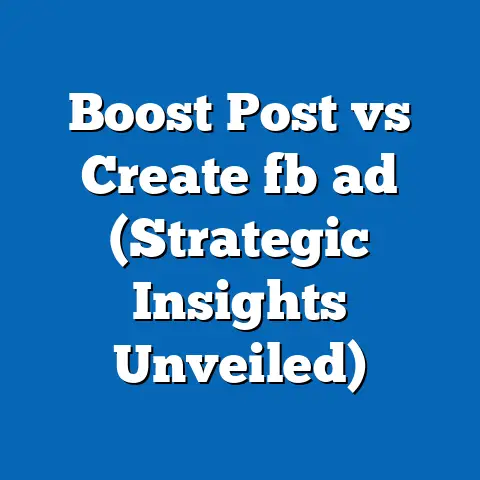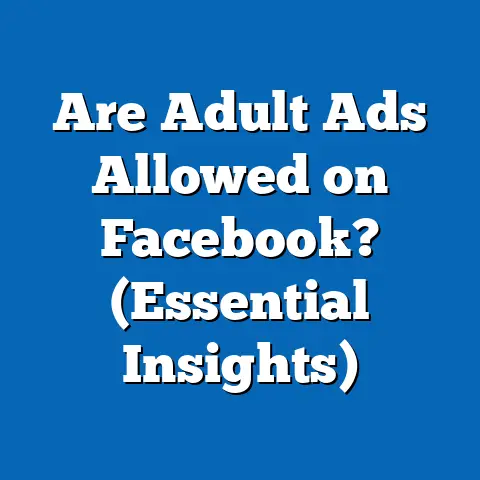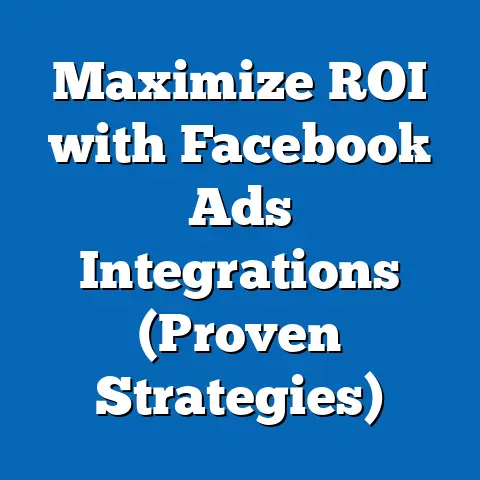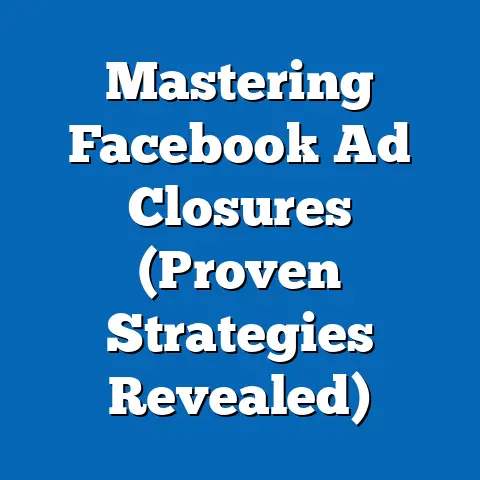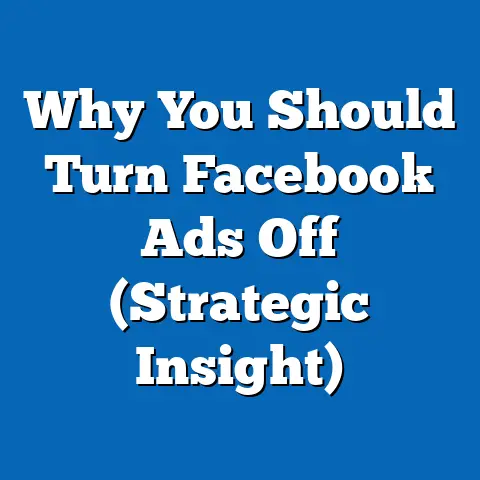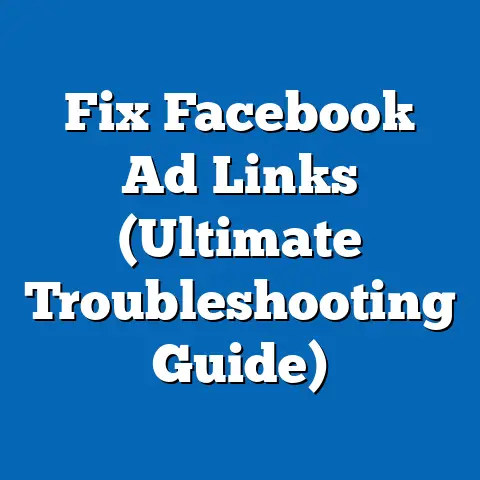Master Facebook Ads for High Conversions (Proven Strategies)
In a world where over 2.8 billion people are active on Facebook, how can you ensure your ads don’t just get seen, but actually convert? I’ve seen firsthand the frustration of business owners and marketers pouring time and money into Facebook campaigns, only to be met with a trickle of engagement and a disappointing conversion rate. It’s like shouting into a crowded room and hoping someone, anyone, will hear your message. The truth is, simply being on Facebook isn’t enough. Mastering Facebook ads is not just beneficial, it’s absolutely essential for success in today’s competitive digital landscape. It’s about learning to speak the language of the platform, understand its nuances, and craft campaigns that resonate deeply with your target audience. Let’s dive into the proven strategies that can transform your Facebook ads from a cost center into a powerful conversion engine.
Understanding the Facebook Ads Ecosystem
Facebook advertising has come a long way since its humble beginnings. I remember back in the early days, the targeting options were pretty basic. You could choose age, gender, and maybe a few broad interests. Now, it’s a sophisticated, data-rich environment where you can pinpoint your ideal customer with laser precision.
The evolution of Facebook advertising is directly linked to the platform’s growth and its ever-increasing user base. As more people joined Facebook and shared more information, the advertising capabilities became more granular and powerful. This means that today, you have access to an incredibly diverse range of targeting options, ad formats, and analytics tools.
Knowing the ins and outs of the Facebook platform is crucial. It’s not enough to simply throw an ad up and hope for the best. You need to understand the different ad formats available – from image ads and video ads to carousel ads and collection ads – and choose the one that best suits your message and your audience.
You also need to be familiar with the various targeting options. Facebook allows you to target users based on demographics (age, gender, location), interests, behaviors, and even connections (people who like your page, friends of people who like your page, etc.). The more you understand these options, the better you can tailor your ads to reach the right people.
And finally, you need to be proficient in using Facebook’s analytics tools. These tools provide valuable insights into how your ads are performing, allowing you to track key metrics like reach, impressions, click-through rate (CTR), and conversion rate. By analyzing this data, you can identify what’s working and what’s not, and make adjustments to your campaigns accordingly.
The Role of the Facebook Ads Manager
At the heart of it all lies the Facebook Ads Manager. This is your command center, the place where you create, manage, and analyze your ad campaigns. It’s a complex tool, but mastering it is essential for effective Facebook advertising.
The Ads Manager allows you to:
- Create new campaigns: You can choose your campaign objective (e.g., awareness, traffic, engagement, leads, sales) and define your target audience, budget, and schedule.
- Design your ads: You can select your ad format, upload your images or videos, and write your ad copy.
- Manage your bids and budgets: You can set your bids (the amount you’re willing to pay for each click or impression) and your budgets (the total amount you’re willing to spend on your campaign).
- Track your performance: You can monitor your key metrics and see how your ads are performing in real-time.
- Optimize your campaigns: You can make adjustments to your targeting, bids, budgets, and ad creative to improve your results.
I’ve spent countless hours in the Ads Manager, tweaking campaigns, analyzing data, and experimenting with different strategies. It can be a daunting tool at first, but with practice and a willingness to learn, you can become a master of the Ads Manager and unlock its full potential.
Key Takeaway: Understanding the Facebook Ads ecosystem, including its features, targeting options, and analytics tools, is crucial for creating high-converting campaigns. Mastering the Facebook Ads Manager is essential for effective campaign management and optimization.
Defining Your Goals and Audience
Before you even think about creating an ad, you need to define your goals and understand your audience. This is the foundation upon which your entire campaign will be built.
Setting Clear, Measurable Goals
What do you want to achieve with your Facebook ads? Are you trying to increase brand awareness, generate leads, drive sales, or something else entirely?
It’s important to set clear, measurable goals that are aligned with your overall business objectives. This will help you to track your progress and determine whether your campaigns are successful.
Examples of clear, measurable goals include:
- Increase brand awareness: Reach 100,000 people within the next month.
- Generate leads: Collect 50 qualified leads through a lead generation form.
- Drive sales: Increase online sales by 15% in the next quarter.
Notice how each of these goals is specific, measurable, achievable, relevant, and time-bound (SMART). This makes it much easier to track your progress and determine whether you’re on track to meet your objectives.
I’ve seen campaigns fail simply because the goals were vague and undefined. It’s like setting out on a journey without a destination in mind. You’ll wander aimlessly and never reach your desired outcome.
Defining and Understanding Your Target Audience
Once you know what you want to achieve, you need to define and understand your target audience. Who are you trying to reach with your ads? What are their demographics, interests, and behaviors?
The more you know about your target audience, the better you can tailor your ads to resonate with them. This will increase your chances of capturing their attention and driving conversions.
Here are some key factors to consider when defining your target audience:
- Demographics: Age, gender, location, education, income, occupation, etc.
- Interests: Hobbies, passions, activities, etc.
- Behaviors: Online behavior, purchase history, device usage, etc.
Facebook provides a wealth of data about its users, which you can use to refine your target audience. You can target users based on their interests, their demographics, their online behavior, and even their connections.
For example, let’s say you’re selling organic baby food. You might want to target parents aged 25-45 who live in urban areas and have an interest in organic food, parenting, and healthy living.
Using Audience Insights to Refine Your Target Audience
One of the most valuable tools for understanding your target audience is Facebook Audience Insights. This tool provides a wealth of data about the people who like your page or who are interested in your products or services.
With Audience Insights, you can:
- Learn about their demographics: See their age, gender, location, education, and relationship status.
- Discover their interests: See what pages they like, what topics they’re interested in, and what activities they engage in.
- Analyze their behavior: See what devices they use, what websites they visit, and what purchases they make.
By using Audience Insights, you can gain a deeper understanding of your target audience and refine your targeting parameters to reach the right people with your ads.
I’ve used Audience Insights to uncover hidden interests and behaviors that I never would have thought of on my own. It’s a powerful tool for gaining a competitive edge and maximizing your ad performance.
Key Takeaway: Defining your goals and understanding your target audience is crucial for creating effective Facebook ads. Use Audience Insights to refine your targeting parameters and ensure that you’re reaching the right people with your message.
Crafting Compelling Ad Copy and Creative
Once you’ve defined your goals and audience, it’s time to craft compelling ad copy and creative that will capture their attention and drive conversions. This is where the rubber meets the road.
Key Elements of High-Converting Ad Copy
Your ad copy is your opportunity to speak directly to your target audience and persuade them to take action. It should be clear, concise, and compelling.
Here are some key elements of high-converting ad copy:
- Clarity: Your message should be easy to understand and free of jargon.
- Urgency: Create a sense of urgency to encourage people to take action now.
- Strong Call-to-Action (CTA): Tell people exactly what you want them to do (e.g., “Learn More,” “Shop Now,” “Sign Up”).
Your ad copy should also be tailored to your target audience. Use language that resonates with them and addresses their specific needs and pain points.
For example, if you’re selling a weight loss program, you might use ad copy that focuses on the benefits of losing weight, such as increased energy, improved health, and greater confidence.
I’ve found that asking a question in your ad copy can be a great way to engage your audience and pique their interest. For example, “Are you tired of feeling tired all the time?”
The Importance of Visuals
In addition to compelling ad copy, you also need to select visuals that resonate with your audience. Your images or videos should be high-quality, eye-catching, and relevant to your message.
Here are some tips for selecting effective visuals:
- Use high-quality images or videos: Avoid blurry or pixelated visuals.
- Choose visuals that are relevant to your message: Your visuals should support and enhance your ad copy.
- Use visuals that are eye-catching and attention-grabbing: Your visuals should stand out in the newsfeed.
- Test different visuals to see what works best: Experiment with different images and videos to see which ones generate the most engagement.
I’ve seen ads with amazing copy fall flat because the visuals were poorly chosen. Remember, people are visual creatures. Your visuals are often the first thing they’ll notice, so make sure they’re making a good impression.
Examples of Successful Ad Copy and Creative
Let’s take a look at some examples of successful ad copy and creative that drove high conversions:
-
Example 1: Shopify
- Ad Copy: “Start your online store today with Shopify. Get a free 14-day trial. No credit card required.”
- Visual: A clean, professional image of a person using the Shopify platform.
- Why it works: The ad copy is clear, concise, and includes a strong CTA (“Start your online store today”). The visual is relevant and professional, conveying trust and credibility.
-
Example 2: Dollar Shave Club
-
Ad Copy: “Tired of overpaying for razors? Join Dollar Shave Club and get high-quality razors delivered to your door for just a few bucks a month.”
- Visual: A humorous video featuring the company’s founder.
- Why it works: The ad copy addresses a common pain point (overpaying for razors) and offers a compelling solution (Dollar Shave Club). The video is funny and engaging, making the ad memorable and shareable.
Example 1: Shopify
- Ad Copy: “Start your online store today with Shopify. Get a free 14-day trial. No credit card required.”
- Visual: A clean, professional image of a person using the Shopify platform.
- Why it works: The ad copy is clear, concise, and includes a strong CTA (“Start your online store today”). The visual is relevant and professional, conveying trust and credibility.
-
Example 2: Dollar Shave Club
-
Ad Copy: “Tired of overpaying for razors? Join Dollar Shave Club and get high-quality razors delivered to your door for just a few bucks a month.”
- Visual: A humorous video featuring the company’s founder.
- Why it works: The ad copy addresses a common pain point (overpaying for razors) and offers a compelling solution (Dollar Shave Club). The video is funny and engaging, making the ad memorable and shareable.
Example 2: Dollar Shave Club
Ad Copy: “Tired of overpaying for razors? Join Dollar Shave Club and get high-quality razors delivered to your door for just a few bucks a month.”
These examples demonstrate the importance of crafting compelling ad copy and selecting visuals that resonate with your audience. By combining these elements effectively, you can create ads that capture attention, drive engagement, and generate conversions.
Key Takeaway: Compelling ad copy and creative are essential for driving conversions on Facebook. Your ad copy should be clear, concise, and include a strong CTA. Your visuals should be high-quality, eye-catching, and relevant to your message.
Leveraging Advanced Targeting Options
Facebook’s advanced targeting options are what truly set it apart from other advertising platforms. The ability to reach specific segments of your audience with tailored messages is incredibly powerful.
Custom Audiences and Lookalike Audiences
Two of the most effective advanced targeting options are Custom Audiences and Lookalike Audiences.
- Custom Audiences: Allow you to target people who have already interacted with your business, either online or offline. You can upload a list of customer email addresses, phone numbers, or Facebook IDs to create a Custom Audience. You can also create a Custom Audience based on website traffic, app activity, or engagement with your Facebook page.
- Lookalike Audiences: Allow you to target people who are similar to your existing customers. Facebook analyzes your Custom Audience and identifies common characteristics, such as demographics, interests, and behaviors. It then finds other Facebook users who share those characteristics and creates a Lookalike Audience.
I’ve seen businesses achieve incredible results by using Custom Audiences and Lookalike Audiences. For example, a clothing retailer might create a Custom Audience of people who have purchased from their website in the past and then create a Lookalike Audience to target new customers who are similar to their existing customers.
The Importance of Retargeting
Retargeting is a powerful strategy that allows you to show ads to people who have previously visited your website or interacted with your business in some way. This is a highly effective way to drive conversions because you’re targeting people who are already familiar with your brand and your products or services.
You can retarget users based on:
- Website traffic: Show ads to people who have visited specific pages on your website.
- App activity: Show ads to people who have used your mobile app.
- Engagement with your Facebook page: Show ads to people who have liked your page, commented on your posts, or watched your videos.
I always recommend that businesses implement retargeting campaigns as part of their overall Facebook advertising strategy. It’s a relatively low-cost way to drive conversions and increase sales.
Using Demographic and Interest-Based Targeting
In addition to Custom Audiences and Lookalike Audiences, you can also use demographic and interest-based targeting to reach your ideal customers.
Facebook allows you to target users based on a wide range of demographic factors, such as:
- Age: Target users within a specific age range.
- Gender: Target users based on their gender.
- Location: Target users based on their location (country, state, city, zip code).
- Education: Target users based on their education level.
- Income: Target users based on their income level.
- Occupation: Target users based on their occupation.
You can also target users based on their interests. Facebook has a vast database of interests that you can use to narrow down your target audience. For example, you can target users who are interested in cooking, travel, sports, or fashion.
I’ve found that combining demographic and interest-based targeting with Custom Audiences and Lookalike Audiences can be a highly effective way to reach your ideal customers and drive conversions.
Key Takeaway: Leveraging advanced targeting options, such as Custom Audiences, Lookalike Audiences, and retargeting, is crucial for maximizing ad relevance and driving conversions on Facebook. Combine these options with demographic and interest-based targeting to reach your ideal customers.
Testing and Optimization Techniques
Facebook advertising is not a “set it and forget it” activity. It requires ongoing testing and optimization to ensure that your campaigns are performing at their best.
The Concept of A/B Testing
A/B testing, also known as split testing, is a method of comparing two versions of an ad to see which one performs better. You create two different ads with slight variations (e.g., different headlines, different images, different CTAs) and then show them to the same target audience. By tracking the performance of each ad, you can determine which version is more effective.
I always recommend that businesses use A/B testing to refine their ad performance. It’s a simple but powerful way to identify what works and what doesn’t.
Key Metrics to Track
There are several key metrics that you should track to measure the performance of your Facebook ads:
- Reach: The number of people who saw your ad.
- Impressions: The number of times your ad was displayed.
- Click-Through Rate (CTR): The percentage of people who clicked on your ad.
- Conversion Rate: The percentage of people who took the desired action after clicking on your ad (e.g., making a purchase, filling out a form).
- Cost Per Acquisition (CPA): The cost of acquiring a new customer through your ad.
By tracking these metrics, you can get a clear picture of how your ads are performing and identify areas for improvement.
Strategies for Ongoing Optimization
Based on the data you collect, you can make adjustments to your campaigns to improve your results. Here are some strategies for ongoing optimization:
- Adjust your bids: Increase your bids if your ads are performing well and decrease your bids if they’re not.
- Adjust your budgets: Increase your budgets for campaigns that are generating a high ROI and decrease your budgets for campaigns that are not.
- Adjust your targeting parameters: Refine your targeting parameters to reach a more relevant audience.
- Experiment with different ad copy and creative: Test different headlines, images, and CTAs to see what works best.
- Monitor your ad frequency: If your ad frequency is too high, people may become annoyed and start ignoring your ads.
I’ve learned that continuous optimization is the key to long-term success with Facebook advertising. It’s about constantly testing, analyzing, and refining your campaigns to get the best possible results.
Key Takeaway: Testing and optimization are essential for maximizing the performance of your Facebook ads. Use A/B testing to refine your ad copy and creative. Track key metrics and make adjustments to your campaigns based on the data you collect.
Utilizing Facebook Pixel for Enhanced Tracking
The Facebook Pixel is a small snippet of code that you place on your website. It allows you to track the actions that people take on your website after clicking on your Facebook ad. This data is invaluable for optimizing your campaigns and driving conversions.
What is the Facebook Pixel?
The Facebook Pixel is a powerful tool that allows you to:
- Track conversions: See which of your Facebook ads are driving conversions on your website.
- Build audiences: Create Custom Audiences of people who have visited your website or taken specific actions on your website.
- Optimize ad delivery: Tell Facebook to show your ads to people who are most likely to take the desired action.
I consider the Facebook Pixel to be an essential tool for any business that’s advertising on Facebook. Without it, you’re flying blind.
Benefits of Using the Facebook Pixel
The benefits of using the Facebook Pixel are numerous:
- Improved tracking: Track conversions and see which of your Facebook ads are driving results.
- Enhanced targeting: Build Custom Audiences of people who have interacted with your website and target them with relevant ads.
- Optimized ad delivery: Tell Facebook to show your ads to people who are most likely to convert.
- Increased ROI: By tracking conversions and optimizing your campaigns, you can increase your ROI on Facebook advertising.
How to Set Up and Use the Facebook Pixel
Setting up the Facebook Pixel is relatively straightforward:
- Create a Pixel: Go to the Facebook Ads Manager and create a new Pixel.
- Install the Pixel code on your website: Copy the Pixel code and paste it into the
<head>section of your website. - Set up event tracking: Add event codes to your website to track specific actions, such as purchases, form submissions, and page views.
Once you’ve installed the Pixel and set up event tracking, you can start using the data to optimize your campaigns.
I’ve seen businesses dramatically improve their conversion rates by using the Facebook Pixel to track conversions and optimize their ad delivery. It’s a game-changer.
Key Takeaway: The Facebook Pixel is an essential tool for tracking conversions, building audiences, and optimizing ad delivery on Facebook. Set up the Pixel on your website and start using the data to improve your campaign performance.
Staying Ahead of Trends and Changes
The world of Facebook advertising is constantly evolving. New features are introduced, algorithms are updated, and best practices change. To stay ahead of the curve, it’s important to keep up with the latest trends and changes.
Keeping Up with Algorithm Changes and Advertising Policies
Facebook’s algorithm is constantly being updated to improve the user experience. These updates can have a significant impact on the performance of your ads.
It’s also important to be aware of Facebook’s advertising policies. Facebook has strict rules about what you can and cannot advertise on its platform. Violating these policies can result in your ads being disapproved or your account being suspended.
I make it a point to stay informed about algorithm changes and advertising policies by reading industry blogs, attending webinars, and following Facebook’s official announcements.
Emerging Trends in Facebook Advertising
Here are some emerging trends in Facebook advertising that you should be aware of:
- Video content: Video ads are becoming increasingly popular and effective.
- Ephemeral ads: Ads that disappear after a short period of time, such as Stories ads, are gaining traction.
- AR/VR integration: Facebook is exploring ways to integrate augmented reality (AR) and virtual reality (VR) into its advertising platform.
Staying Informed Through Industry Resources
There are many great resources available to help you stay informed about Facebook advertising. Here are some of my favorites:
- Facebook’s Business Help Center: The official resource for information about Facebook advertising.
- Industry blogs: Follow leading industry blogs, such as Social Media Examiner and AdEspresso.
- Webinars: Attend webinars hosted by industry experts.
I’ve found that staying informed is critical for maintaining a competitive edge in the ever-changing world of Facebook advertising.
Key Takeaway: Staying ahead of trends and changes is crucial for long-term success with Facebook advertising. Keep up with algorithm changes and advertising policies. Be aware of emerging trends and stay informed through industry resources.
Conclusion
Mastering Facebook Ads for high conversions is a journey, not a destination. It requires continuous learning, experimentation, and adaptation. The strategies I’ve outlined in this article provide a solid foundation for success. From understanding the Facebook Ads ecosystem and defining your target audience to crafting compelling ad copy and leveraging advanced targeting options, these techniques can help you transform your Facebook ads from a cost center into a powerful conversion engine.
While the journey may be complex, the rewards of high conversions and successful campaigns are well worth the effort. Don’t be afraid to experiment, test new strategies, and learn from your mistakes. With dedication and a willingness to adapt, you can unlock the full potential of Facebook advertising and achieve your business goals.
Call to Action
Now it’s your turn! Take the first step toward mastering Facebook Ads by implementing one of the strategies discussed in this article. Whether it’s setting up the Facebook Pixel, creating a Custom Audience, or A/B testing your ad copy, take action today and start seeing results.
Share your experiences or insights in the comments section below. Let’s learn from each other and build a community of successful Facebook advertisers! I’m eager to hear about your successes, your challenges, and your questions. Together, we can navigate the complexities of Facebook advertising and achieve high conversions that drive real business growth.

